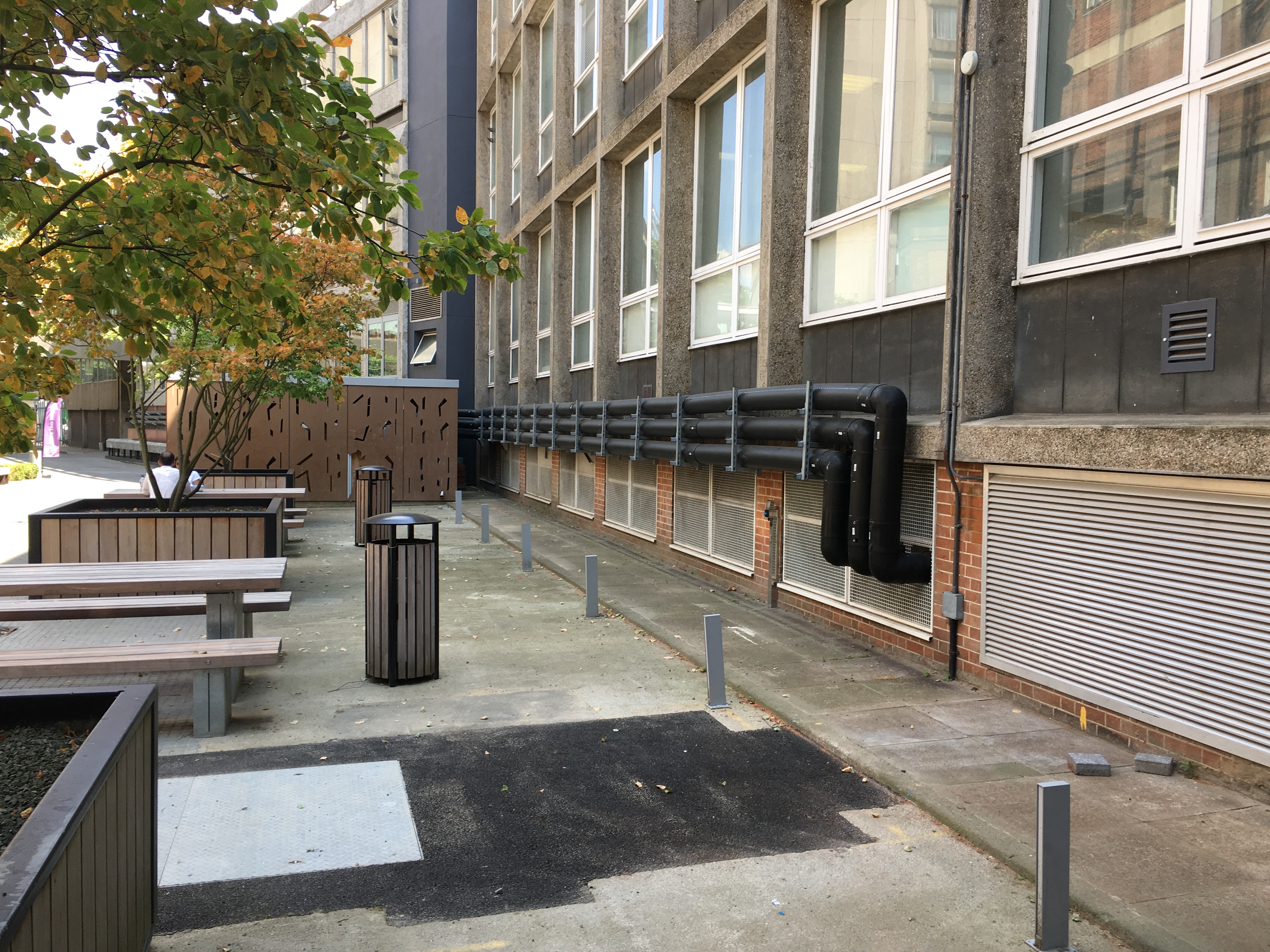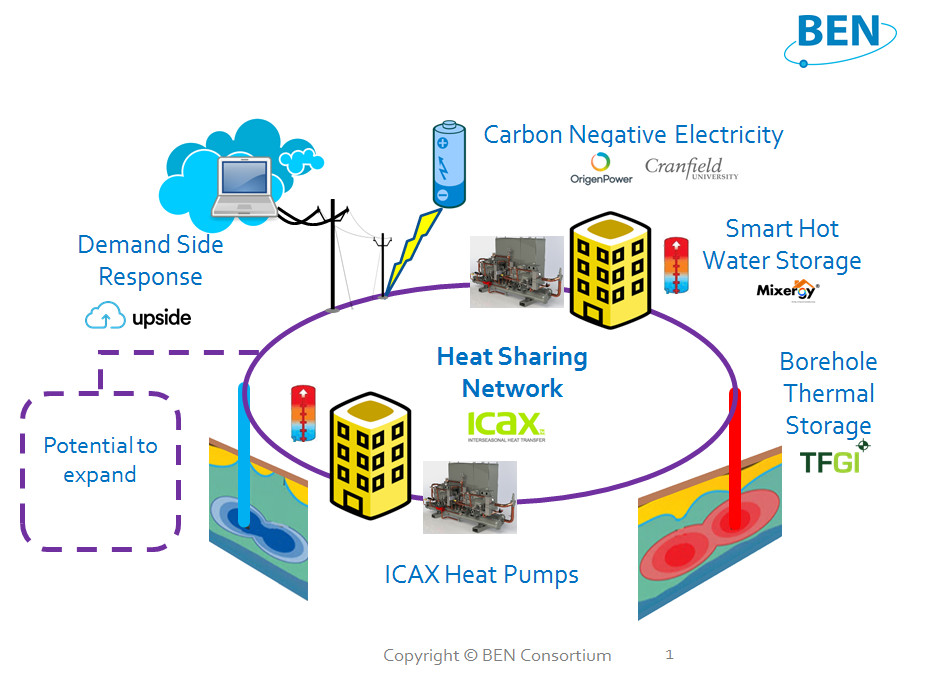Balanced Energy Networks
ICAX and LSBU have constructed a Balanced Energy Network at the London South Bank University site in Southwark in conjunction with consortium partners in a £4 million project part funded by Innovate UK.
The BEN consortium brings together cross-sector supply chains to deliver integrated energy solutions at different scales to meet the energy systems challenges of achieving a low-carbon economy: secure, affordable, sustainable energy.
The Balanced Energy Network is the first Fifth Generation District Heating Network constructed in the UK.
The heart of the network is the efficient use of renewable energy based on the recycling of solar heat (from the summer) to thermal energy storage in the ground through the autumn, to the time of need for heat (in winter).
Heat pumps are used to transfer heat to buildings in winter instead of generating heat afresh when needed by burning fossil fuels. ICAX has developed heat pumps which can deliver high temperatures so that they can be retrofitted into existing buildings in place of gas boilers and use existing heat distributions systems directly.
Heat is recovered from buildings needing cooling and transferred to those needing heating and domestic hot water on a heat sharing network.
Balancing the supply and demand for heat through the seasons is mirrored by balancing the supply and demand for electric power by shifting some of the demand from times of peak consumption (by day) to times of excess supply (by night).
BEN Consortium
The BEN Consortium consists of:
- ICAX which has developed Interseasonal Heat Transfer to enable buildings to be heated in winter with solar energy captured in the previous summer and developed high temperature heat pumps to allow heat pumps to replace gas boilers in retrofit installations.
- The Centre for Efficient and Renewable Energy in Buildings, CEREB, is London South Bank University's unique teaching, research and demonstration resource for the built environment, hosting a number of renewable and intelligent energy solutions.
- Upside Energy has developed a cloud service that aggregates the energy stored in systems people and businesses already own (uninterruptible power supplies, solar PV systems, electric vehicles, domestic heating systems). This creates a “virtual energy store” that can be sold to the grid to help the grid balance supply and demand.
- Mixergy has developed heavily insulated domestic hot water tanks with novel inlet stratification to allow extended thermal energy storage. Mixergy can exploit the cheap rate electricity negotiated by Upside to heat DHW when prices are cheapest (often at night). Mixergy can exploit a "demand response" by reaction to a low price signal from Upside. Other users of electricity in the Balanced Energy Network, such as heat pumps, can take advantage of cheaper tariffs for restricted periods in the same way.
- Terra Firma Ground Investigation has expertise in open and closed loop borehole drilling for exploiting ground source energy.
- Origen Power and Cranfield University are developing a fuel cell calciner to enable electricity to be generated in a way that removes CO2 from the atmosphere.
- The GLA is contributing to the consortium as a stakeholder with an interest in maintaining and protecting London's environment and resources (water, energy and waste) and ensuring that they are used more efficiently. The Greater London Authority is working to reduce air pollution and greenhouse gas emissions in London, to help tackle climate change and increase the city's resilience to extreme weather.
- Winckworth Sherwood is contributing time to advise on resolving the legal barriers to establishing district heating networks.

Heat Sharing Dividend
Heat Sharing Networks are designed to provide a more cost effective, flexible, and scalable alternative to conventional district heating network technology. Heat Sharing Networks transfer warmth via a piping circuit between buildings at near ground temperature and extract it via heat pumps in each building: an intranet of heat.
This radical innovation allows the integration of diverse energy systems through the recovery of low grade waste heat, delivery of simultaneous heating and cooling, links to heat storage in boreholes and provides lower installation costs by making use of existing infrastructure, none of which are possible with conventional high temperature heat networks.
When buildings require cooling then heat can also be released into the district circuit and this benefits those buildings that need heating. This results in a flexible heat sharing network that is to the advantage of both those releasing heat and those extracting heat: both parties benefit from a "heat sharing dividend".
The Intranet of Heat
This new heat infrastructure is the birth of an "Intranet of Heat". The Intranet of Heat enables the exchange of information about sources and needs of heat – and cooling – and then allows heat exchange from those buildings with surplus heat to those in need of heat: a contribution to the circular economy.

The Energy Trilemma
The BEN Consortium is accepting the challenge from government to resolve the Energy Policy Trilemma:
- by using heat networks,
- by using heat transfer instead of combustion,
- by delivering a heat sharing dividend,
- by accelerating the electrification of heat
- and by employing "demand response" to focus on using off-peak electricity.
Demand Response
Demand side response can be used to shift the timing of electric demand from hours of peak demand to times of surplus supply. DSR requires a bi-directional energy grid to signal when prices are low to trigger additional use (and to signal when prices are high to inhibit additional use).
Urban Air Quality
Balanced Energy Networks is also addressing the growing problem of air pollution in London: the network provides heating without employing combustion or releasing any gasses on site.
Electrification of heat
The Balanced Energy Network at LSBU now provides heating to the main buildings on the LSBU campus by heat transfer from the London aquifer – the original gas boilers have been retained as back-up, but are only called in to work on the very coldest days in winter.
Balanced Net Zero Pathway
The Climate Change Committee has recommended to government that the UK should adopt a Balanced Net Zero pathway to 2050 and maps the following targets:
- a 68% reduction in carbon emissions (compared to 1990) by 2030
- a 78% reduction in carbon emissions (compared to 1990) by 2035
- a net 100% reduction in carbon emissions (compared to 1990) by 2050
ICAX believes that these targets are realistic and recommends that one practical route to get there is by installing Balanced Energy Networks, although this will not be achieved until government reduces the "environmental levies" on electricity which are, ironically, a major barrier on the route to Net Zero.
See new website for BEN See Internet of Energy
See Ground Source Heating See Ground Source Cooling See Ground Source Energy












